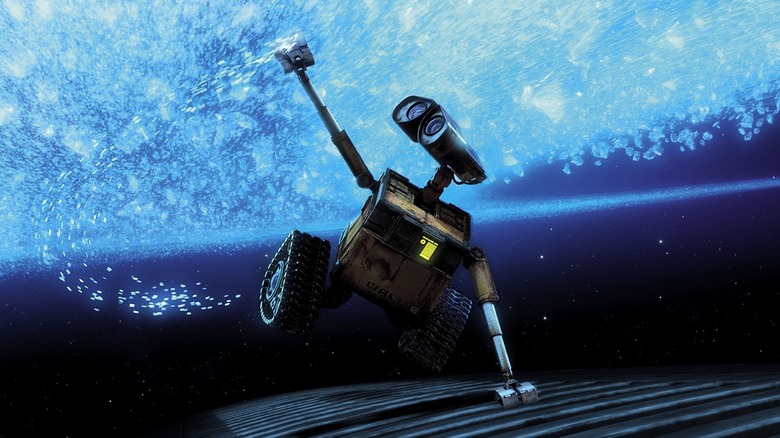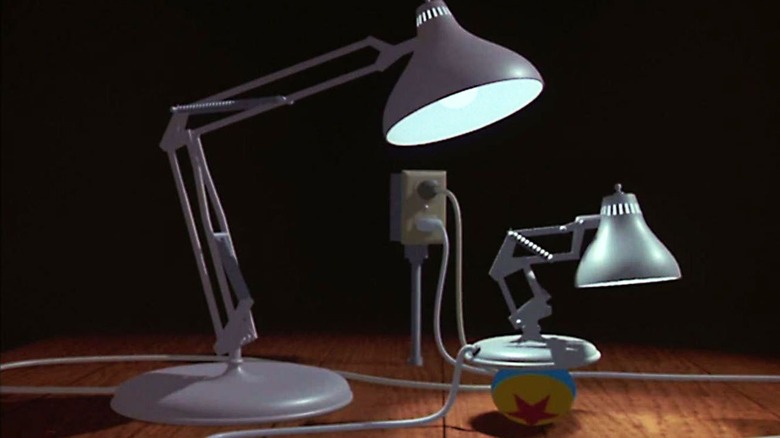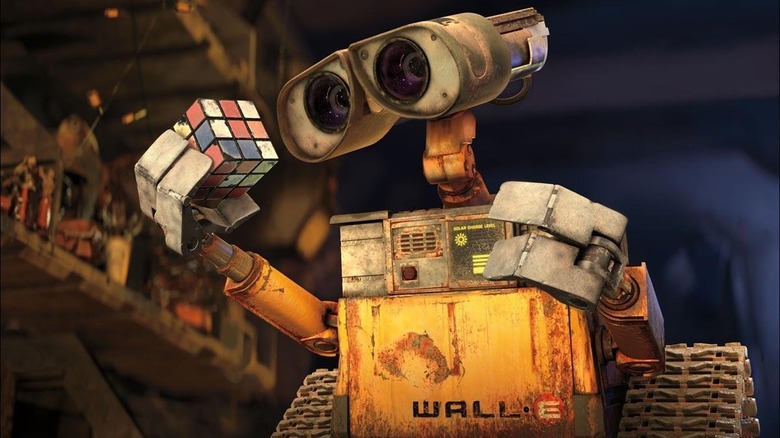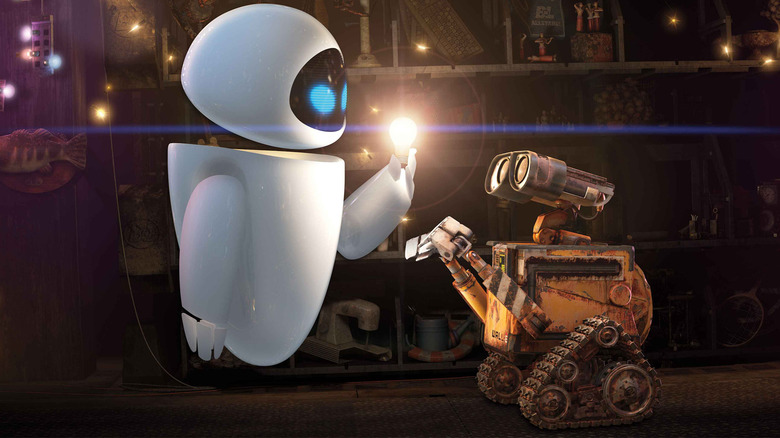Wall-E's Origins Go Back To The Earliest Days Of Pixar
It's easy when you're a kid to give just about anything a personality of its own. It doesn't have to be a toy; it could be an old shoe, an empty bottle, or a weirdly shaped stick. Give it a voice and move it around a bit and, hey presto, another character to play with. Most of us lose that uninhibited imagination as we get older, which may be a reason why animation — sometimes derisively categorized as kid's stuff — still captures the hearts and minds of so many adults.
Disney has long been the master of the anthropomorphic sidekick; I'm thinking Thumper in "Bambi," singing teapots in "Beauty and the Beast," and a very emotive magic carpet in "Aladdin." More recently, Pixar got in on the action when they brought a whole host of inanimate plastic objects to vivid life in "Toy Story." Since then, the studio has given us talking cars, lost little fish, eyeballs on legs, and a whole host of other lovable nonhuman characters.
Many of the films hinge on a simple, perfectly realized premise: What if toys came to life when humans weren't around? What if there were a rat who dreamed of becoming a chef? What if Earth became so cluttered with junk that mankind took to the stars, leaving a lonely robot behind to clear up the mess?
Even by the groundbreaking standards of the studio, "WALL-E" remains Pixar's most ambitious film to date, pushing their school of anthropomorphism to the limit. For the first mostly wordless 40 minutes of the film, our only company is a box on wheels with expressive eyes, his pet cockroach, and a sleek probe droid with an itchy trigger finger. Yet all this might not have been achievable without the story of a playful little lamp.
Who is Luxo Jr.?
If you've seen a Pixar movie without skipping the opening credits, you're almost certainly familiar with Luxo Jr. He's the cute little desk lamp who hops into the frame when the Pixar Animation Studios logo comes up, jumping up and down on the "I" and flattening it. He is the Pixar mascot, and his importance to the company goes all the way back to 1986, with the studio's first animated short in their modern form.
"Luxo Jr." was the creation of John Lasseter, who studied character animation at Cal Arts and worked for Disney and Lucasfilm before the computer animation department was spun off into its own independent company, Pixar. He worked day and night, even sleeping in his office, to complete the two-minute short film in time for the SIGGRAPH conference, where it was greeted with rapturous applause. The film was a breakthrough for the computer animation industry, but Lasseter was concerned with two key aspects that would shine through when it came to making full features. He explained in an interview with Animato! magazine (via HarryMcCracken.com):
"The thing I wanted to do in Luxo Jr. was make the characters and story the most important thing, not the fact that it was done with computer graphics. As you see in the film show at SIGGRAPH, a lot of times it's computer graphics for computer graphics nerds. People get excited about it purely because it was generated with a computer."
"Luxo Jr." is still a delight. While the animation still looks good for its age, the most remarkable thing is how much character Lasseter gives the lamps. Despite the lack of easily anthropomorphic features, they still display curiosity, surprise, eagerness, affection, excitement, sadness, reproach, shame, and exasperation. Not bad for a film about two household appliances.
The origins of WALL-E
Andrew Stanton, who would go on to win an Oscar for "Finding Nemo," came up with the basic premise for "WALL-E" during a lunch in 1994 with fellow Pixar creatives John Lasseter, Pete Docter, and Joe Ranft. With "Toy Story" in production, they realized they might actually get the chance to make some more movies and pitched around ideas. The concepts for "A Bug's Life," "Finding Nemo," and "Monsters, Inc." were all first discussed, as well as one that particularly appealed to Stanton. He said (via "WALL-E" production notes):
"One of the things I remember coming out of it was the idea of a little robot left on Earth. We had no story. It was sort of this Robinson Crusoe kind of little character — like, what if mankind had to leave Earth and forgot to turn the last robot off, and he didn't know he could stop doing what he's doing?"
Stanton decided to make his central character a machine-like robot rather than a humanoid one, taking inspiration from Lasseter's earlier work with the lamps (via Cinema Blend):
"John had made 'Luxo Jr.,' this little short about this little lamp hops around. It's just an appliance; it's not even made to look like a character. It's just happens to be an appliance that you could easily, by its own design, throw a character on to it. That short is powerful. I've had to watch that thing about 1,000 times. Every time, just before we put it on I think, 'Geez I have to watch this again.' And I get caught up every time. There is some unique power to bringing that type of machine to life than other kinds of machines that are designed to look like a character."
A final touch to the design
With the concept and approach for "WALL-E" locked in, Andrew Stanton took inspiration for the design from an unlikely source: attending a baseball game (via Cinema Blend):
"I hadn't designed Wall-E yet. I knew he had to compact trash, so I knew he was going to be a box. I knew he was going to collapse to show that he's shy, but that's all I had. Honestly, I was thinking of putting a single cone lamp on there because I loved how you read a face into the simplicity of Luxo, but I didn't think it would hold for 90 minutes. When I got handed the binoculars, I missed the entire inning. I just turned the thing around and started staring at it. I started making it go sad and then happy and then mad."
WALL-E's design works a treat and, like John Lasseter's cute lamp, we get all his characteristics in a purely visual way. He's plucky, resourceful, caring, dutiful, inquisitive, lonesome, and romantic, with a thrift store junkie's eye for a gem among the trash. Opening with an almost wordless stretch set in a dystopian, junk-choked future Earth was a bold choice that might have skirted disaster if the protagonist weren't so instantly adorable, and the first third of "WALL-E" is a masterclass in visual storytelling and immersive world building. You can even see a little of Luxo's movement in the way our hero cranes his robotic neck.
"WALL-E" won numerous awards, including an Oscar for Best Animated Feature, and even became one of only four animated films to make the lofty Sight & Sound Top 250. It's a film that will continue to delight many generations of viewers in the future, even as piles of garbage dwarf their own cities.



